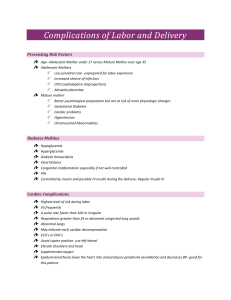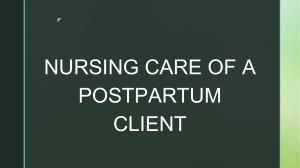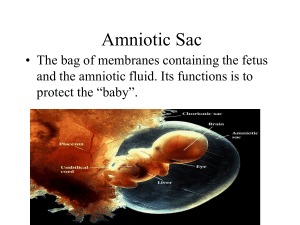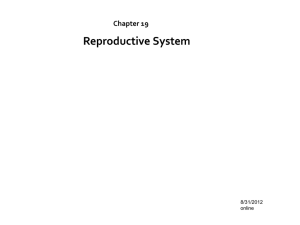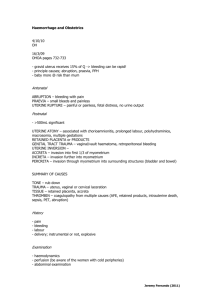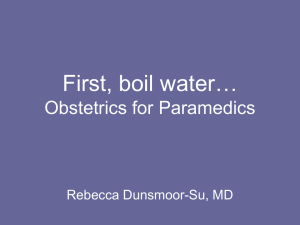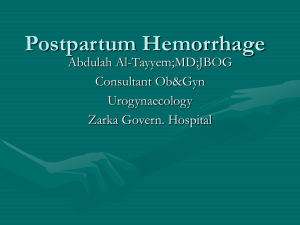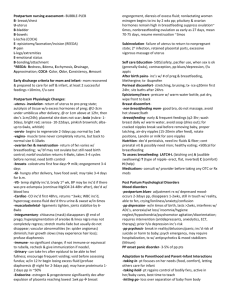N222 Lecture 11 - College of San Mateo
advertisement
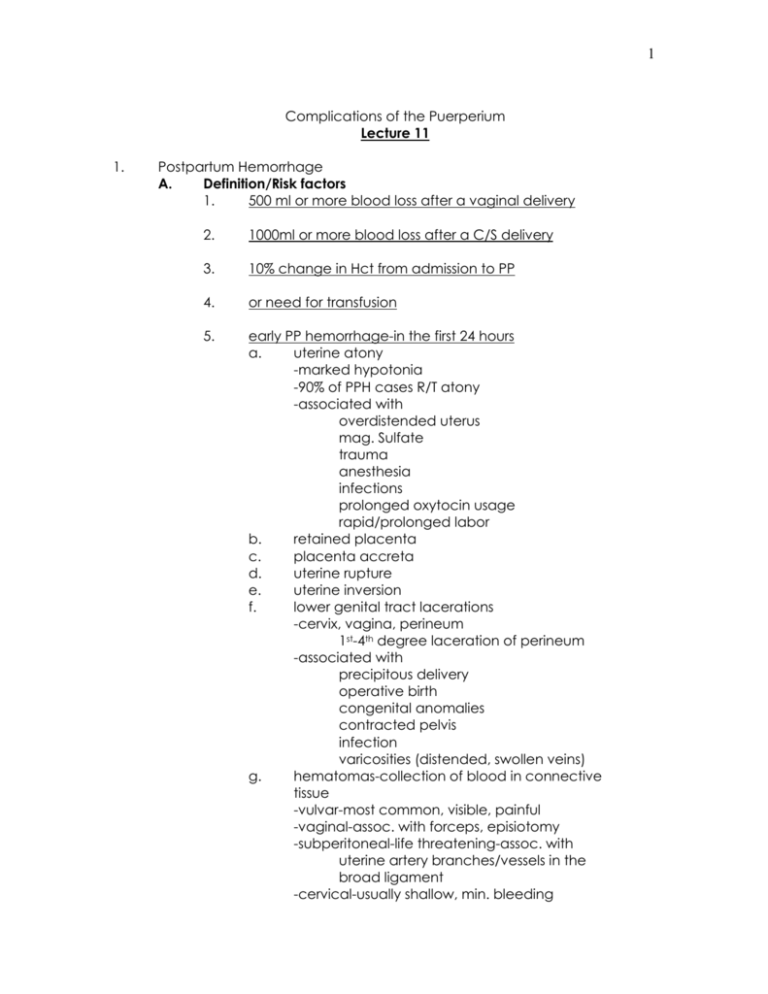
1 Complications of the Puerperium Lecture 11 1. Postpartum Hemorrhage A. Definition/Risk factors 1. 500 ml or more blood loss after a vaginal delivery 2. 1000ml or more blood loss after a C/S delivery 3. 10% change in Hct from admission to PP 4. or need for transfusion 5. early PP hemorrhage-in the first 24 hours a. uterine atony -marked hypotonia -90% of PPH cases R/T atony -associated with overdistended uterus mag. Sulfate trauma anesthesia infections prolonged oxytocin usage rapid/prolonged labor b. retained placenta c. placenta accreta d. uterine rupture e. uterine inversion f. lower genital tract lacerations -cervix, vagina, perineum 1st-4th degree laceration of perineum -associated with precipitous delivery operative birth congenital anomalies contracted pelvis infection varicosities (distended, swollen veins) g. hematomas-collection of blood in connective tissue -vulvar-most common, visible, painful -vaginal-assoc. with forceps, episiotomy -subperitoneal-life threatening-assoc. with uterine artery branches/vessels in the broad ligament -cervical-usually shallow, min. bleeding 2 h. i. infections coagulopathies 6. late PP hemorrhage-after 24 hrs to 6 weeks PP a. subinvolution of the uterus -delayed return of the enlarged uterus to normal size -caused by infection, retained placenta -S & S: prolonged lochia, excessive bleeding palpable boggy uterus, fundal height greater than expected b. retained POC c. endometritis 7. dark blood-probably venous-varices/superficial lac. 8. bright red blood-arterial-deep laceration of cx B. Complication-Hypovolemic shock C. Care management 1. if hypotonic uterus a. massage b. express clots-1 gm=1ml (weigh pads) c. assess for tachycardia, ↓ BP, tachypnea, pale cool skin, Δ in LOC, lethargy d. large bore IV’s-LR 1000 ml with 10-40 units pitocin -watch for water intoxication, N & V e. empty bladder or place Foley cath f. O2 10-12L/min via mask if oxygen saturation low g. Methergine 0.2 mg IM-produces sustained U/C -elevates BP, N & V, headache -may exacerbate cardiac disease h. if unsuccessful-prostaglandin F2a (Hemabate) given IM or intramyometrially -headache, N & V, diarrhea, fever -may aggravate asthmatics i. Bakri balloon j. herbal remedies -witch hazel -motherwort-promotes U/C, vasocontrictive -blue cohosh-oxytocic -nettle-↑ available Vit. K, ↑ Hgb -Shepard’s purse-promotes U/C -red raspberry leaves-promotes U/C k. follow-up with labs -CBC -coag panel 3 -type and cross match D. II. 2. bleeding with contracted uterus a. assess for clots in lower uterine segment b. inspection of vagina, cervix, perineum c. suture bleeding lacerations d. for hematoma -cold packs -ligation of bleeding vessel 3. uterine inversion a. reposition uterus b. tx shock c. oxytocin d. broad spectrum abx e. NG tube if concerned R/T paralytic ileus 4. subinvolution a. oxytocin/ergonovine b. D & C if placenta fragments retained Teaching 1. normal lochia progression 2. review factors associated with hemorrhage 3. check for bladder distention 4. inspect perineum/vaginal pads 5. assess fundus 6. if S & S change, call MD immediately Thromboembolic disorders A. Classifications 1. superficial venous thrombosis a. most common type PP b. involves superficial saphaneous vein 2. deep vein thrombosis a. most common type during pregnancy b. involves veins from foot to iliofemoral 3. pulmonary embolism a. blood clot dislodged-carried to pulmonary artery b. occludes vessel-obstruct blood flow to lungs 4 B. C. D. III. Incidence/etiology 1. superficial venous thrombosis-1 out of 500-750 women 2. declined R/T early ambulation 3. causes: venous stasis, hypercoagulation, & injury to blood vessel 4. risk factors: C/S, obesity, AMA over 35 yrs, h/o DVT, DM, smoker, varicose veins Clinical manifestations 1. superficial-pain/tenderness/warmth/redness 2. deep-unilateral leg pain/calf tenderness/swelling 3. pulmonary-dyspnea/tachypnea/apprehension/cough tachycardia/hemoptysis/pleuritic chest pain Case management 1. diagnosing a. Homan’s sign-can be false positive b. Doppler U/S (VUS) c. venography-less common-exposes mom/fetus to radiation d. pulmonary arteriogram 2. analgesic-antiinflammatory agent (i. e. Motrin) 3. rest, elevation, warm packs, elastic stockings (TEDS) 4. DVT-tx with anticoagulants-IV heparin→po Warfarin 5. PE-IV heparin therapy, supportive care 6. if Coumadin ordered-need OC therapy -teratogenic to fetus Infections A. Risk Factors -C/S -prolonged labor -poor health status -OB trauma -pre-existing vag. infection -manual removal of placenta -PPROM -multiple vaginal exams -FSE/IUPC -chorioamnionitis -vacuum/forceps delivery -lapse in aseptic technique 5 B. Classifications 1. puerperal sepsis-any infection of genital canal within 6 weeks of miscarriage, abortion, or birth 2. endometritis-infection of the lining of the uterus a. most common PP infection b. usually starts at placental site c. higher incidence with C/S d. most frequent culprits: GBS, chlamydia 3. parametritis (pelvic cellulitis) a. involves connective tissue of broad ligament b. if spreads to peritoneum=peritonitis c. may be result of pelvic vein thrombophlebitis 4. wound infection a. often develops at home b. C/S site, episiotomy, laceration site c. broad-spectrum abx may be used 5. UTI’s a. b. c. 6. C. D. occur in 2-4% of PP women risk factors: Foley, epidural, freq. exams, C/S most frequent culprit: E. coli mastitis a. affects 5-10%, most first-time mothers b. develops unilaterally c. usually Staph aureus, E. coli, Streptococcus d. if organism is Candida→oral thrush in babies Manifestations 1. fever, chills, ↑ pulse, fatigue, lethargy, pain, tenderness 2. profuse foul-smelling lochia, leukocytosis, ↑ sed rate 3. wound separation, dehiscence 4. dysuria, frequency, urgency 5. redness, warmth Case management 1. abx appropriate for organism-improve hydration 2. encourage proper perineal hygiene 6 IV. 3. rest, analgesics, supportive care a. warm blankets b. sitz bath c. Tucks pads d. cool compresses to peri 4. continue breastfeeding or pumping breasts 5. reinforce good handwashing techniques 6. consider I & D for wound if needed 7. assist with ADL’s or baby care Psychiatric disorders A. PP Blues 1. 50-80% of women experience the baby blues B. 2. emotionally labile, cry often and for no reason 3. peaks day 5, usually ends day 10 4. mild depression, fatigue, poor concentration, H/A 5. etiology unknown 6. feeling overwhelmed with parental responsibility 7. let-down feeling, lack connection of mom to fetus 8. needs to learn coping strategies, seek support grps 9. 5-30% of this group will experience PP depression PP depression-PP Major Mood Disorder 1. intense, pervasive sadness, severe/labile mood swings 2. symptoms rarely disappear without help 3. feel intense fear, anger, anxiety, and despondency 4. feelings of guilt/inadequacy fuel worry of being incompetent parent 5. odd food cravings, binge eating, sleeping heavily 6. distinguishing feature: irritability 7 C. 7. prominent feature: rejection of the infant R/T jealousy 8. may have thoughts about harming the baby/self 9. with tx, gradually improves in 6 months 10. Tx a. b. c. d. psychotherapy antidepressants anxiolytic agents electroconvulsive therapy PP depression with psychotic features (PP psychosis) 1. depression, delusions, and thoughts of harming infant or self 2. occurs in 1-2 of 1000 births/up to 50% chance to reoccur with subsequent births 3. behavior evident within 1-3 months PP 4. initial complaints: agitation, fatigue, insomnia, restlessness, emotionally labile-inability to move or work 5. then suspiciousness, confusion, incoherence, irrational statements, and obsessive concerns R/T infant’s health 6. delusions in 50% of cases, hallucinations in 25% 7. severe delusions/hallucinations will command mom to kill infant or have her believe the baby is possessed by the devil 8. nursing staff should be on alert for mothers who are agitated, overactive, confused, or suspicious 9. course of syndrome similar to that seen in people with mood disorders 10. psychiatric emergency: antidepressants and lithium 11. mother may not be able to breastfeed on certain medications 12. will probably need psychiatric hospitalization 8 V. 13. use screening tools: PP depression-pp 851-853 14. follow-up with advanced practice psychiatric RN a. home visits b. meet with mental health therapist c. support groups Loss and Grief-pp. 481-488 A. Situational life crises 1. infertility B. 2. premature labor/birth 3. C/section 4. loss of control during birth process 5. birth of a boy when expecting a girl/visa versa 6. birth of a handicapped child 7. maternal death-7-8 out of 100,000 women 8. fetal death-6.8 out of 1000 births 9. neonatal death-27,000 yearly Phases of grief-(denial, anger, bargaining, depression, acceptance) 1. acute distress a. loss of identity as parent b. loss of a dream/hope c. state of shock/numbness d. confusion, disbelief, denial e. may have outburst of emotion or lack affect f. need to accept the loss g. normal functioning impeded/hard to make decisions h. may need help with funeral arrangements 2. intense grief a. loneliness, emptiness, guilt, yearning, anger b. have to accommodate the changes the loss has created-i.e. the nursery, clothes c. have to return to work-possibly meet insensitive coworkers/family d. difficulty handling leakage of breast milk-a reminder of loss 9 e. f. g. h. 3. C. guilt feelings may intensify if mother thinks she is being punished for a prior bad act responses: anger, bitterness, resentment focused anger on health care team for not saving the infant’s life physical symptoms: H/A, fatigue, dizziness, backaches reorganization a. search for a meaning to the tragedy b. improved function at home and work c. start to enjoy simple pleasures without guilt d. reestablishing relationships e. “bittersweet grief”-grief response occurring with reminders of the loss f. grief can also be triggered by subsequent births Communication and caring 1. actualize the loss 2. provide time to grieve 3. interpret normal feelings/allow for individual differences 4. provide for the cultural/spiritual needs of parents 5. assist with their physical comfort 6. offer options a. see and hold the baby b. bath and dress the baby c. privacy d. visitation for other family/friends e. religious rituals f. special memorials/pictures 01/16
